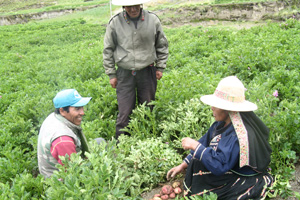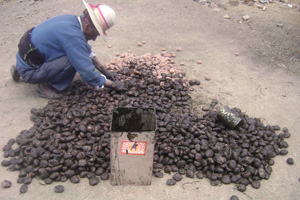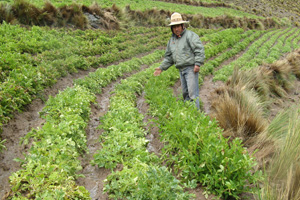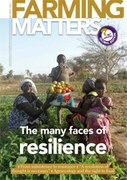Dealing with the uncertainties of changing climates is a challenge faced by farmers around the world. Near Cochabamba in Bolivia’s Andean high plateau, a group of agroecological farmers are leading the way by developing and sharing innovative practices that help their communities break out of the vicious cycle of increased poverty and vulnerability. But challenges remain…

Tapacarí province near Cochabamba is one of the most vulnerable municipalities in Bolivia, with 99% of the population living below the poverty line and 89% in extreme poverty.
Challa is one of the four cantons or districts, at 3500-4600 metres above sea level, with only 300-600 mm annual precipitation and an average temperature of 6.5°C. The entire population here depends on subsistence agriculture with only very limited capacity to produce excess for sale.
Agricultural potential is very low, relative vulnerability is high, and temporary and permanent migration is one of the few alternative survival strategies. Yet, they have developed coping mechanisms that are based on a combination of local wisdom gathered over centuries, and knowledge of agroecological production techniques.
Enter the Yapuchiris
Traditional knowledge has been created and preserved over many centuries, but in recent decades much has been lost for reasons such as ‘modern’ education, the technological ‘progress’ of the Green Revolution practices, and changes in the market. And in this challenging environment, enter the Yapuchiris.
Traditional ‘leader’ farmers, they collect, create and share agroecological knowledge and risk management strategies in the local area. Blending ancestral knowledge with newly adopted practices, Yapuchiris experiment on their own land then teach other farmers and local organisations about their successes.

manure. Photo: Projecto GRAC
Anyone can be a Yapuchiri. In Tapacarí, farmers either volunteer or are elected by their community. They incorporate their varied wisdom and experiences into a process of research, dialogue, reflection, documentation, training, and exchange of knowledge. They focus on the management of different crops, experimenting with agroecological practices, preparing and testing biological inputs, intercropping, evaluating yields, weather recording, applying risk management tools, and so on. They travel around their own and neighbouring communities, sharing their experiences with other farmers in their ‘Yapuchiri tent’ at local fairs, but also via posters, flyers and radio programmes. They also collect farmers’ questions and concerns which enrich their experimentation and future research.
Local attitudes and public policies are slowly seeing the true value of how traditional knowledge and practices improve the management and resilience of farming systems. In Bolivia, the new National Political Constitution of 2009 recognises the government’s duty to protect the rights of indigenous peoples, and respect, value, promote and protect their traditions and wisdom. Although this is a great achievement, more effort is needed to translate these laws into concrete strategies and actions. Moreover, there are still no policies that focus on climate risk management, or that could support the evident local capacity in this area of the Yapuchiris.
Our research
“The most frequent threats are hail and frost which can cause losses of 50-100% in our main crops,” says Facundo Poma, a Yapuchiri from Challa district. Other climate change related problems mentioned by the farmers besides hail and frost were, too much rain, crop diseases, snow and strong winds, in order of decreasing importance. To assess the impacts of climate risks, and the strategies to address them used by rural communities, we undertook a survey of farming families in the district.
We divided farmers into three groups. First are the Yapuchiris who practice agroecology, treat plants with biological inputs and use multiple practices in response to climate threats, then farmers assisted by Yapuchiris or older parents who know and share traditional practices, and finally, farmers who use very few risk-avoidance practices.
The diversity of local responses
The survey identified a total of 34 different practices that the farmers used to manage climate risks. At least a few risk reduction practices were used by 72% of the surveyed farmers. This included all of the Yapuchiris and 82% of farmers accompanied by Yapuchiris. On the other hand, only 15% of farmers not accompanied by Yapuchiris used any such measures. We also looked at the source of the knowledge about these practices The survey found that 57% of the climate risk reduction practices were adapted from ancestral knowledge, 20% from knowledge from external institutions, 12% from farmer exchanges and 11% from farmers’ own initiatives.

Most of the practices and strategies were agronomic in nature, including the timely mounding up of soil around plants, improving soil fertility by manuring and re-ploughing, agroecological soil and water conservation measures, use of bio-fertilizers, pest and disease control, seed selection, disinfection and presprouting. Yapuchiris identify and mark the healthiest and most robust potatoes when they are flowering, to be saved for planting the following year. And before sowing seeds, they are disinfected with a paste made from special type of animal manure, or a mixture of spicy wild plant seeds, lime and sulphur.
Other strategies were socio-cultural, and included various rituals, and predicting the weather by observing natural indicators such as flowering dates of certain plants, the appearance of animals (birds, insects, reptiles), and presence of clouds, wind or rain during holidays or certain phases of the moon.
Complementary practices
The practices applied varied from one planting season to another according to the presence of climatic phenomena and to what production and risk management practices were already incorporated into the production system. Yapuchiris used a greater diversity of strategies, simultaneously or in complement, and were at least twice as likely to implement any of the risk reduction practices compared to other farmers.
Agronomic and risk management practices at system or component level are not separate in the minds of Yapuchiris, but are considered complementary in increasing buffering capacity in the face of extreme climate events.
These findings and the history of climatic events show that the impacts of natural phenomena are local in nature, and actions have to be taken first at the family and community level. Support should be focused on strengthening capacities for addressing climate risk based on ancestral knowledge and local knowledge but also modern scientific knowledge, complementing each other and offering various options.
To what extent has the use of these practices improved output and reduced production losses in the face of climate change? A survey of the potato harvest in Challa in 2013 clearly showed the positive impacts. The average yield was 8 tonnes per hectare, increasing to 13 tonnes amongst farmers that were helped by Yapuchiris, while the Yapuchiris themselves produced an average 21 tonnes per hectare. But even some farmers not assisted by Yapuchiris still use their knowledge as a reference when making decisions on production and risk management, as when asked why they use a certain practice, they replied by saying, “I watch the Yapuchiris” or “because the Yapuchiris do it”.
Ideals and constraints
The ideal would be for each community to have a group of Yapuchiris and the economic support to enable them to improve the service they provide and knowledge sharing within communities. But reality is different. There are invisible barriers which corrode the values and principles of cooperation and interrelationships and prevent sharing, replication and building. These include individualism and egoism among the rural people, and external factors that are difficult to manage. For example, modern cultural and educational influences tend to override ancestral customs such as reciprocity, solidarity and respect for individuals and nature; aspects which should be promoted within communities to contribute to achieving and sustaining well being.
In spite of the importance of Yapuchiris, limitations are evident. Firstly, it is a simple numbers game. In Challa, there are only 24 Yapuchiris who actively assist other farmers, which is clearly inadequate given that there are 1850 families spread between 27 communities in the district. Another aspect is the time required to assist and accompany other farmers without neglecting their own farms, and who should pay Yapuchiris for the extra time and travel costs needed to share their knowledge?
Efforts were made to overcome these limitations in 2013. The Yapuchiris presented a proposal to the Municipality of Tapacarí asking for resources to strengthen and facilitate their work. They also tried to encourage local education authorities to follow new policies aimed at promoting training and education of children and youth in risk management. The municipality expressed an interest but has not yet shown the political will to fully support such initiatives and take advantage of local capacities.
Building climate resilience
Using and strengthening local capacities and the role of the Yapuchiris are the best way for communities to manage climate risk and to build resilience in the face of climate change. It is also necessary to recover traditional knowledge and practices, study them and adapt them, especially given that most climate change impacts are local and actions by public entities are marginal. The lack of capacity to act and react makes communities more vulnerable to climatic events, reducing family and communal food security with effects on society as a whole. These are essential aspects that should be taken into account when defining public policies for the management of climate risk.
Sustainable agroecological production can address new climate challenges. But this requires observing, strengthening and building new capacities at the local level, and initiating dialogue that promotes and diffuses different kinds of knowledge. We hope that our findings about the role of Yapuchiris and traditional knowledge will contribute to the spread of local agroecological practices as a viable climate risk management strategy.
Tania Ricaldi Arévalo and Luis Carlos Aguilar
Tania Ricaldi Arévalo is Director of Economics and Planning at the Center for Post-Graduate Studies at Upper San Simon University, Bolivia, Luis Carlos Aguilar works for the AGRECOL Andes Foundation, and both work for the Management of Communal Agricultural Risk project.
Email: taniaricaldia@gmail.com
The authors thank the Association of Agroecological Producers of Challa District and all farmers and Yapuchiris who shared their valuable knowledge and experience, and the McKnight Foundation for financial support.

